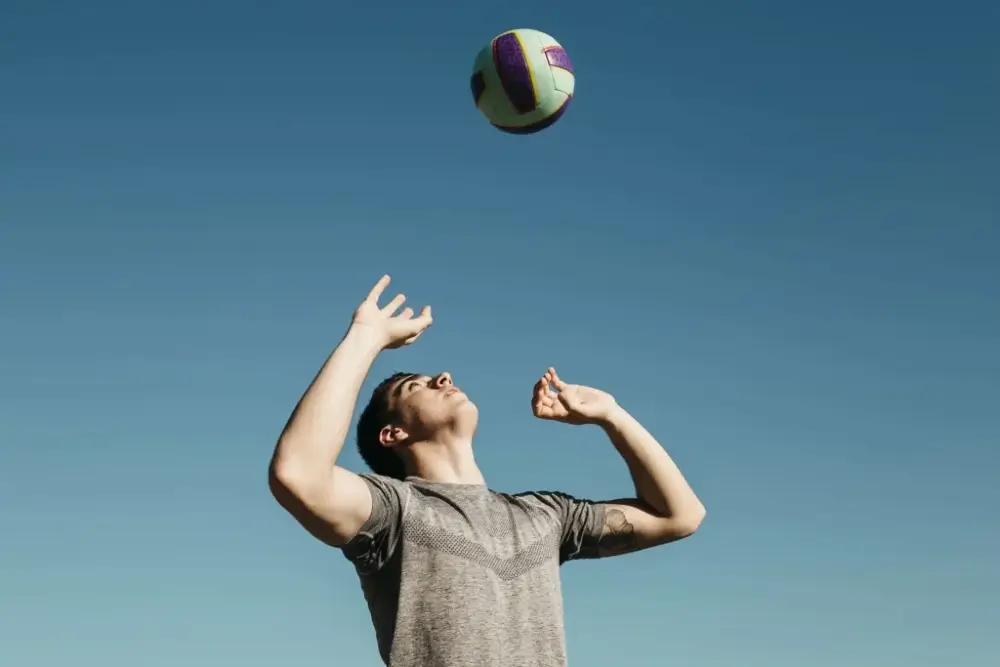Last Updated: November 29, 2023
In volleyball, just like other sports, a player either acquires a particular skill through training or is born with it. This is no different for the setter’s position. A person suited for this role naturally possesses some unique skills and abilities.
A setter is mainly mandated to set the ball to a hitter who, in turn, makes the final kill. However, their responsibility doesn’t end there; they should also communicate all alignment changes and give the players regular feedback on each play. Moreover, a setter sets strategies for better offensive plays.
What natural traits set pro setter apart? Read on.
Traits of a Pro Setter

Having the below traits is necessary for a setter to become a pro in their skill. However, a setter should train hard to better their skill to stand out.
1. Good Communicator
A setter should maintain constant communication with teammates and the coach as they specifically touch more of the balls than other players. Success in volleyball can’t be achieved without teamwork. Nonetheless, communication is vital for efficient teamwork. A setter should communicate with team members even under tough situations or in intense matches.
2. Physically Fit
A setter won’t receive good passes all the time. Sometimes, they have to chase bad passes and still need to make a good set or play long rallies, which can be physically daunting. A setter who is physically fit delivers outstanding sets no matter the challenges they encounter.
Though not a must, a setter should have a tall, athletic body that makes it easy to make vertical jumps. Performing regular exercises is great for keeping the setter’s body physically fit, which is vital for them to deliver powerful sets and organize strategic plays.
3. Exhibit Mental Toughness
A setter is a team’s driving force and can either lower or build their confidence. A born setter treats each play individually regardless of the previous play or score. The ability to be resilient through hard moments allows the setter to strategize their next moves and try to pull the team through. That’s not all, a setter should take criticism positively and learn from their mistakes.
Recommended read: From Assists to Aces: The Dynamic Role of Setters in Modern Volleyball
4. A Leader in Challenging Situations
A setter is basically a leader or an on-court coach. In most cases, the setter is the team captain and should ensure a good relationship between the teammates, officials, and coach. A setter should understand their teammate’s strengths and weaknesses then work on ways to bring out the best in them.
5. Have Passion for the Game
Show natural passion for setting by exhibiting curiosity and willingness to learn new strategies. A coach can have a hard time trying to teach a player who isn’t dedicated to learning a particular art. Being passionate helps a player to hone their skills easily, which is handy for success on the court.
6. Good Analytical Skills
As the game develops, a setter should quickly examine the opponent’s defense by evaluating their strengths and weaknesses. This helps them to make necessary changes that would help their team to penetrate the opponent’s court and get more points. The setter can also analyze their team member’s weaknesses and advise them on how to improve their skill.
Also read: Setting Higher Standards – Trends and Innovations in Volleyball Setting This Year
7. Versatile
A great setter ought to be versatile and able to perform different sets, including back sets, quick sets, or shoot sets. This gives the team a variety of options to choose from and boost their offensive play. Additionally, versatility helps confuse the opponents and leaves them guessing about your team’s next move, thus forming a good ground for earning points.
8. Full Court Awareness
A setter should be mentally aware of all the activities on the court and analyze the exact positions of opponents, teammates, and ball movement. The court’s visual awareness helps the setter to make quick decisions on possible target areas to aim the ball for successful play.
9. Agile and Make Quick Moves
For a setter to be successful in volleyball, they should have great agility by changing their direction quickly. Staying in an athletic stance and having swift footwork allows the setter to be ready to move. After receiving the ball, the setter should move swiftly to get it to a setting spot and be ready to deliver an appropriate set to the hitter.
10. Quick Decision Maker
Many coaches love a setter who is a quick thinker and makes timely decisions. The setter always knows where the ball should go and why. Understanding which opponent player is struggling and advising their hitter accordingly is handy for steering a team to success. In case the setter sees mistakes or gets instructions from the coach, they should perform in-game adjustments when the need arises.
For example, through evaluating the situation on the ground, a setter decides on a specific play, though it’s the most challenging one. They should do it without doubting themselves and have a mindset that the set will be safe. Taking appropriate risks differentiates a great setter from one who is less daring which can influence the game negatively.
11. Left Hand Advantage
Though not mandatory, a left-handed setter has more advantages than a right-handed one. A left-hander brings variety to a team’s offensive strategy by introducing unpredictable sets that confuse the opponents.
Related: How Setters Create Opportunities for Scorers
Conclusion
A lot of effort is required from a setter as they are a team’s driving force. A setter virtually dictates all of the team’s aspects, from setting the pace to determining which hitter to direct the set and the overall game flow.
As a setter, you should have the essential attributes of being mentally resilient, physically fit, be a good communicator, have leadership skills, and be naturally gifted to achieve greater success in this position.
